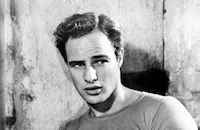Set in a hospital ward full of young men, crippled by their war injuries, The Men addressed several postwar problems that Americans preferred to ignore. What happened to these soldiers who went off to fight for their country and came back mutilated or paralyzed, unable to return to their former jobs, deserted by their wives or girlfriends, forgotten by former friends? How do they readjust to a society that seems to hold no future for them? At the core of the film is an emotionally intense performance by Marlon Brando as an embittered paraplegic who is unable to come to terms with his shattered body or his fiancee (Teresa Wright), who still wants to marry him.
The Men was Brando's film debut and he was an inspired choice for the lead. The director recalls his impressions of the actor in Fred Zinnemann: An Autobiography (Charles Scribner's Sons): "Brando arrived. He seemed fine, if a bit surly and very much on the defensive. It was obvious that he didn't trust any one of us and that he was determined to keep his own counsel. He was still very much the Stanley Kowalski of A Streetcar Named Desire, stuck in that character, and he brought some of that into his performance in The Men. It was fascinating to see how deeply the 'Method' actors would merge into the characters they are playing and how long it took before they could return to being themselves again....It took a bit of time to get used to Brando. Things were difficult for him and he was under enormous strain, having to adjust to the new medium. And why not? People of such enormous talent should be allowed some extra elbow room....This was the way Brando prepared himself: he spent three weeks - day and night - living with the men on one of the paraplegic wards. He found out not only how they moved and behaved, but how they felt and what they thought. They gradually accepted him as one of their own and he became one of them. He shared their physiotherapy, played water polo with them and went to their drinking sessions at the Pump Room. Soon only a doctor or a nurse could tell that he was not a paraplegic."
Prior to the actual filming of The Men, Zinnemann spent many weeks at the Birmingham Veterans Hospital in Van Nuys, California, consulting with several patients, three of whom were hired as technical advisors. One of these was Bud Woziak, a first lieutenant who had been hit in the back by a bullet while on combat patrol; screenwriter Carl Foreman used him as the model for Brando's character. Several paraplegics were also hired for the supporting roles, such as Arthur Jurado, who has a very natural, charismatic screen presence. Other standout performances include Everett Sloane, a former member of Orson Welles' Mercury Theatre, in the key role of Dr. Bors, as well as Teresa Wright, Richard Erdman, and Jack Webb, who made his film debut two years earlier in He Walked By Night and had just launched his new TV series, Dragnet.
Unlike the Oscar-winning Best Picture of 1946, The Best Years of Our Lives, which also touched on some of the sensitive issues faced by returning veterans, The Men was not a commercial success, though it did receive an Academy Award nomination for Best Screenplay. Nevertheless, Zinnemann remained proud of his achievement and continued to explore similar postwar themes in his subsequent film, Teresa (1951), which focuses on an emotionally disturbed veteran and his Italian war bride.
Producer: Stanley Kramer
Director: Fred Zinnemann
Screenplay: Carl Foreman
Art Direction: Rudolph Sternad
Cinematography: Robert de Grasse
Costume Design: Joe King, Ann Peck
Film Editing: Harry Gerstad
Original Music: Dimitri Tiomkin
Cast: Marlon Brando (Ken Wilozek), Teresa Wright (Ellen Wilozek), Everett Sloane (Dr. Brock), Jack Webb (Norm), Richard Erdman (Leo), Virginia Farmer (Nurse Robbins), Arthur Jurado (Angel), DeForest Kelley (Physician).
BW-87m. Closed captioning.
by Jeff Stafford
























